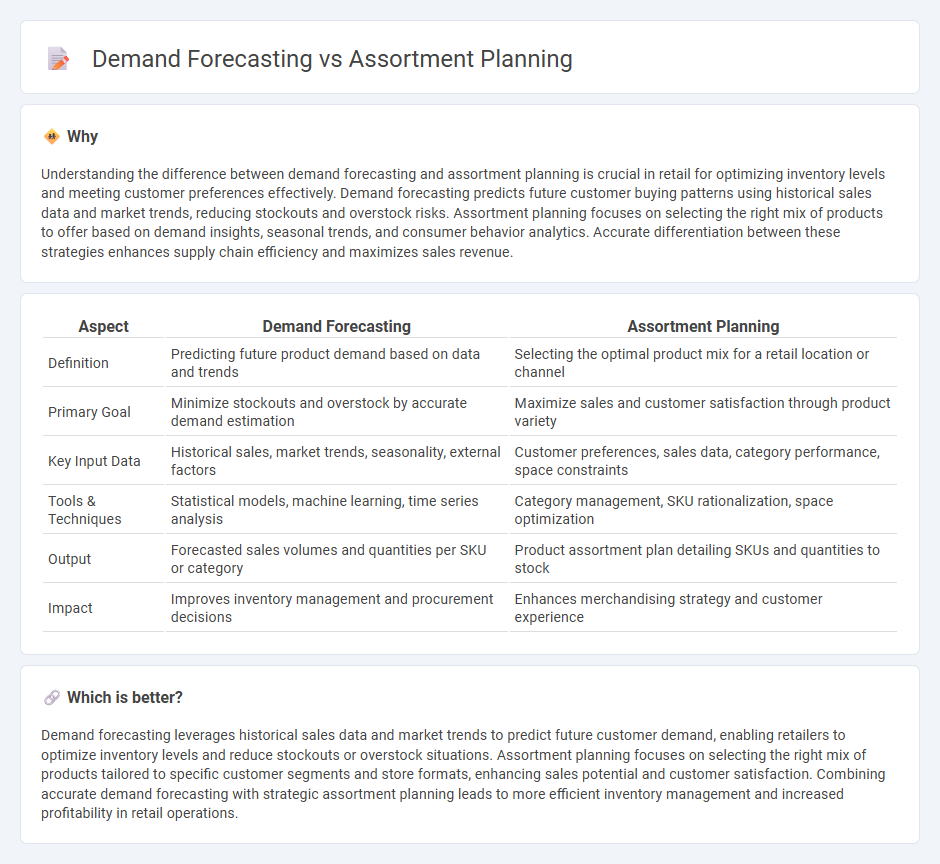
Demand forecasting predicts customer purchasing behavior using historical sales data, market trends, and seasonality to optimize inventory levels and reduce stockouts or overstock. Assortment planning focuses on selecting the right mix of products tailored to specific stores or customer segments, balancing variety and profitability to enhance shopper satisfaction. Explore more about how these strategies drive retail success and operational efficiency.
Why it is important
Understanding the difference between demand forecasting and assortment planning is crucial in retail for optimizing inventory levels and meeting customer preferences effectively. Demand forecasting predicts future customer buying patterns using historical sales data and market trends, reducing stockouts and overstock risks. Assortment planning focuses on selecting the right mix of products to offer based on demand insights, seasonal trends, and consumer behavior analytics. Accurate differentiation between these strategies enhances supply chain efficiency and maximizes sales revenue.
Comparison Table
| Aspect | Demand Forecasting | Assortment Planning |
|---|---|---|
| Definition | Predicting future product demand based on data and trends | Selecting the optimal product mix for a retail location or channel |
| Primary Goal | Minimize stockouts and overstock by accurate demand estimation | Maximize sales and customer satisfaction through product variety |
| Key Input Data | Historical sales, market trends, seasonality, external factors | Customer preferences, sales data, category performance, space constraints |
| Tools & Techniques | Statistical models, machine learning, time series analysis | Category management, SKU rationalization, space optimization |
| Output | Forecasted sales volumes and quantities per SKU or category | Product assortment plan detailing SKUs and quantities to stock |
| Impact | Improves inventory management and procurement decisions | Enhances merchandising strategy and customer experience |
Which is better?
Demand forecasting leverages historical sales data and market trends to predict future customer demand, enabling retailers to optimize inventory levels and reduce stockouts or overstock situations. Assortment planning focuses on selecting the right mix of products tailored to specific customer segments and store formats, enhancing sales potential and customer satisfaction. Combining accurate demand forecasting with strategic assortment planning leads to more efficient inventory management and increased profitability in retail operations.
Connection
Demand forecasting provides critical sales predictions that inform assortment planning by identifying which products and quantities are needed to meet customer preferences. Accurate demand forecasting minimizes inventory costs and stockouts while maximizing sales potential through optimized product selection. Retailers rely on the synergy between both to align inventory levels with market demand and improve overall profitability.
Key Terms
Assortment planning:
Assortment planning strategically selects the optimal mix of products to maximize sales and meet customer preferences while balancing inventory costs and shelf space constraints. It leverages data on consumer behavior, market trends, and historical sales to design a tailored product lineup for specific stores or regions. Discover how effective assortment planning can enhance retail performance and customer satisfaction.
Product mix
Assortment planning centers on selecting the right product mix to meet consumer preferences and maximize sales within available shelf space, whereas demand forecasting predicts future product demand based on historical sales, market trends, and seasonality. Effective product mix optimization relies on integrating demand forecasting data to ensure inventory aligns with anticipated customer needs and avoid stockouts or overstock. Explore deeper insights on how optimizing assortment planning and demand forecasting drives retail success.
Category management
Assortment planning in category management involves selecting the optimal mix and variety of products to meet customer preferences and maximize sales within specific categories. Demand forecasting uses data-driven analysis to predict future customer demand, enabling more accurate inventory allocation and reducing stockouts or overstock situations. Explore more to understand how integrating both strategies enhances category performance and profitability.
Source and External Links
The Ultimate Guide to Retail Assortment Planning - Assortment planning is the process of selecting and organizing a store's product mix by analyzing data, forecasting demand, selecting products, and optimizing SKUs to align inventory with customer preferences and market trends.
Assortment Planning in Retail: What Today's Brands Need ... - Assortment planning involves segmentation, localization, store planning, and financial alignment to make data-driven decisions about product selection and distribution, using strategies like deep, narrow, or wide assortments based on retailer goals and shelf space.
What is Assortment Planning? How to Improve - It is a process to help retailers choose the right products at the right time and price by balancing product variety, customer preferences, inventory management, pricing, seasonality, and vendor relationships to maximize sales and profitability.
 dowidth.com
dowidth.com